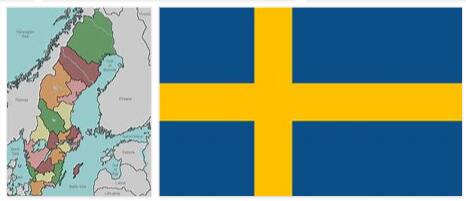Demographic data. – The population of Sweden was 6,371,432 at December 31, 1940 (census), which, according to population assessments, rose to 6,763,685 as of December 31, 1946. The average annual increase was 0.35% between 1930 and 1935, by 0.38% between 1935 and 1940 and by 0.93% between 1940 and 1946.
From 1939 to 1946 93,406 people immigrated to Sweden and 25,135 emigrated, of which 3188 in the US. The urban population increased from 11 to 42.3% of the total between 1860 and 1946. All the cities have marked more or less notable population increases (Stockholm now has 690,000 residents, Gothenburg 326,000, Malmö 177,000; no other reaches 100,000 residents); another 9, beyond 17 in 1934, now exceed 20 thousand residents: Soma, Karlskoga, Kalmar, Landskrona, Kristianstad, Trollhättan, Södertälje, Uddevalla and Sundswall. The table in the following column gives the population of the various provinces according to the 1946 calculation.
Economic conditions. – The growing industrialization of Sweden is clarified by the percentage of residents engaged in industrial and commercial activities since the middle of the century. XVIII to the present day: 9.5 in 1751; 19.8 in 1870; 38.2 in 1900; 50.2 in 1920; 57.6 in 1940. Although agriculture and livestock only affect 1/10 (or a little more) of the country’s land area, the imbalance between food needs and the quantity of products supplied by the internal market is mitigated by the high unit yields, which even come, in good years, to cover the national needs (cereals, potatoes, sugar). After 1939 there was a decrease in the cultivated areas and, consequently, in the harvests, all lower than the averages of the pre-war period (except for potatoes).
The breeding remains flourishing; the consistency of the livestock as at 10 June 1946 reveals a slight decrease in cattle (2.9 million head, against 3.0 in 1938) and horses; a number of pigs instead (1.2 million heads against 0.9 in 1938), sheep and goats. The production of milk (3.4 million tonnes in 1945), butter (93.4) and cheese (35.5) is increasing.
Forests occupy about half of the land area in Sweden (22.3 million ha.); of these 20% have a predominance of pine trees, 18% of fir trees, 22% of conifers only, 33% of conifers and broadleaves mixed, 6% of deciduous trees only. For the production of timber (30-35 million cubic meters per year, on average) Sweden occupies the first place in Europe (leaving the USSR aside); and the same happens for the industries that derive from it (sawmills, furniture, cellulose, paper and cardboard, etc.). For wooden matches, the Swedish trust has come to control up to 85% of world production. For the export of timber, on the other hand, it ranks 4th in the world, after Canada, the USSR and Finland.
The Swedish mining industry remains dominated by iron extraction and processing. In 1946 the production of crude iron was held at 670,000 t. (692,000 in 1937), but that of steel rose to 1.2 million t. (992,000 in 1938). Electrometallurgy, mechanical, chemical and rubber industries are in continuous progress.
Foreign trade. – The trade balance usually closes in deficit (however, made up to a greater or lesser extent by the freight rates of the merchant marine). Here are the related data:
In imports, manufactured goods, textiles and clothing items and food products prevail (in value); exports include timber and derivatives, minerals and related artifacts and machinery. Among the suppliers the first places are held by the US, Great Britain, Switzerland and Argentina; among customers from Great Britain, Norway, the Netherlands, Belgium and France. The Italian-Swedish interchange is remarkable; Italy usually imports much more (timber, steel, sulfur rings) than it does export (cereals and pasta, fruit, vegetables, furniture, wine, hats, marble and sulfur).
Communications. – As of 10 June 1947 there were 90,265 km in Sweden. of national roads. The total length of the railways in 1946 was 16,756 km., Of which 12,041 belong to the state. About 1/3 of the entire network is electrified. The merchant navy consists (1 June 1947) of 2078 ships with a total tonnage of 1.8 million tons. Air communications have had a great development, both with European countries and with the US and Africa (Stockholm-Addis Ababa line).
Finances. – Sweden, despite the inevitable reduction in trade with foreign countries, found itself at the end of hostilities in an initially decidedly favorable economic situation. Production had indeed suffered a certain decline, but the country’s monetary and financial reserves remained intact, the stocks of goods were substantial and a high level of employment had been maintained; this allowed a marked development of exports during 1945 (see above the figures on foreign trade). At the same time, however, also imports, especially of raw materials, recorded a rapid increase due to the growing needs of production. Indeed, from 1946 onwards they largely exceeded exports, leading to growing balance-of-payments deficits. to cover which it was necessary to use the country’s foreign exchange reserves (the National Bank’s gold and foreign exchange reserves, which went from 2083 million crowns in 1938 to 2782 million in 1945, fell in December 1948 to 604 million). The revaluation of the krona, decided on 13 July 1946 (exchange rate with the dollar raised from 4.20 to 3.60 kroner), contributed to these developments, with the aim of preventing the international inflationary process from having repercussions on the Swedish market, as well as of promote imports to stimulate internal production and thus encourage exports of manufactured goods. However, these forecasts have not come true, both due to restrictions imposed by foreign countries for currency reasons, and to the increase in Swedish export prices, determined by the higher cost of imports and by the increases in wages which have occurred in the meantime; as a consequence, the problem of the balance of payments deficit became so acute that the government was forced to review the policy initially adopted of freedom of imports and to gradually re-establish severe restrictions, which however did not have the desired effectiveness, partly due to parallel developments in the government’s monetary and financial policy. For Sweden public policy, please check petsinclude.com.
In the pre-war period government action had manifested itself in two directions, namely, on the one hand, in the effort to keep the purchasing power of the crown stable, and on the other, in pursuing the policy of full employment through control and control. attenuation of economic cycles. From 1937, the year in which the phase of depression was succeeded by that of economic recovery, the first objective began to find itself in partial conflict with the second and the government made use of the means at its disposal (interest rate, prices, changes, state budget), adapting its policy from time to time to developments in the economic cycle. He thus managed, during the war, to prevent an excessive rise in prices and to stabilize wages, but, once the conflict was over, the policy of full employment has assumed predominant importance and the principle of guaranteeing the real wage through the stabilization and reduction of prices has in part replaced that of the revaluation of nominal wages. The main instrument for achieving full employment was the low interest rate policy, maneuvered through substantial purchases of government bonds by the National Bank, whose portfolio of government bonds increased from 434 million in 1945 to 3,317 million. of crowns in December 1948; this policy, while facilitating productive investments (especially in the construction sector), on the other hand neutralized the deflationary effects of the trade balance deficit and favored, by accentuating the liquidity of the market, internal consumption to the detriment of export trade. The consequent inflationary pressure was aggravated by the evolution of monetary incomes (wage increases) and only minimally offset by the government’s fiscal policy (current budget surpluses) since, faced with the expansion of private investments, it does not seem to have been the state ones were sufficiently compressed (the general state budget continued to present itself in deficit). The resulting general economic imbalance has resulted, as we have seen, in the deficit situation of the balance of payments, which it is hoped however can be remedied above all with American aid within the framework of the European reconstruction plan.
The state budget thus varied over the period 1939-48.
The public debt (all internal) amounted in December 1948 to 11.598 million crowns (1938 = 2566 million). Monetary circulation had gone from 980 million in 1938 to 3113 million in December 1948; in September 1948 deposits with commercial banks amounted to 7.3 billion (1938 = 4 billion), those with ordinary and postal savings banks amounted to 8.5 billion (1938 = 4.3 billion).









